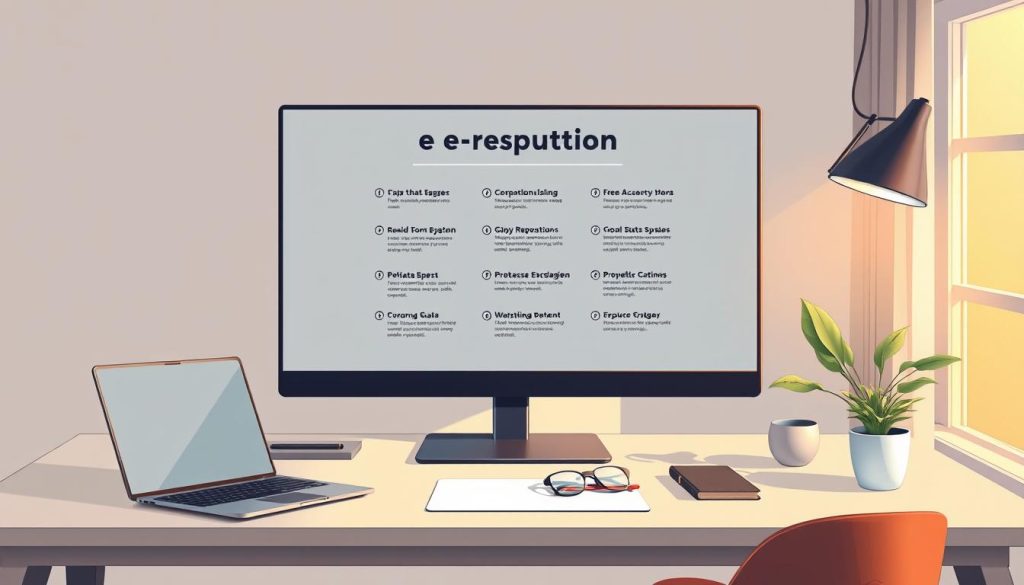What if your greatest professional asset isn’t your skills or experience—but how the world perceives you? In an era where 75% of hiring managers actively research candidates online, your digital footprint has become your most powerful business card. For independent professionals, this reality demands more than talent—it requires intentional visibility.
The concept of strategic self-marketing has evolved far beyond résumé-building. Platforms like LinkedIn and shifting recruitment practices have transformed how expertise is showcased. Today, your marque—the unique blend of skills and personality you present—determines whether clients see you as a commodity or an indispensable partner.
Consider this: 68% of freelancers struggle to differentiate themselves in saturated markets. The solution lies in crafting a cohesive narrative that highlights your unique value proposition. Our guide to branding for freelancers reveals how to turn specialized knowledge into magnetic client attraction.
Table of Contents
Key Takeaways
- Modern success requires blending professional credibility with authentic self-expression
- Digital-first markets demand strategic visibility across multiple platforms
- Differentiation stems from showcasing expertise through targeted contenu
- Consistent branding increases client trust and project quality
- Evolution from service provider to thought leader drives premium pricing
This isn’t about self-promotion—it’s about creating professional gravity. We’ll unpack actionable strategies to build a self-sustaining reputation that attracts ideal clients while maintaining genuine connections. Ready to transform how the market values your work?
Understanding the Concept of Personal Branding
In a world where first impressions increasingly happen through screens, your professional identity extends far beyond qualifications. We’ll explore how modern experts shape perceptions through intentional self-presentation—a practice that’s become non-negotiable for career success.
From Business Cards to Digital Footprints
The strategic process of reputation management has transformed dramatically. What began as networking at industry events now requires multi-platform storytelling. As Jeff Bezos famously noted:
« Your brand is what people say about you when you’re not in the room. »
Three critical shifts define this evolution:
- Traditional résumés → Dynamic digital portfolios
- Local connections → Global thought leadership
- Reactive job hunting → Proactive client attraction
What Experts Want You to Know
Industry leaders emphasize that effective marque personnelle isn’t self-promotion—it’s value communication. Successful professionals blend technical skills with:
- Authentic storytelling
- Visual identity cohesion
- Strategic content sharing
This approach builds trust across client interactions, from initial discovery calls to long-term partnerships. The key lies in consistency—every tweet, LinkedIn post, and project deliverable should reinforce your core message.
Recognizing the Benefits for Independent Professionals
Independent professionals often navigate markets where 83% of buyers struggle to distinguish between similar service providers. Without corporate backing, your marque personnelle becomes the decisive factor in winning projects and building lasting partnerships.
Three core advantages emerge for those who invest in strategic self-presentation:
| Challenge | Strategy | Outcome |
|---|---|---|
| Blending into crowded markets | Develop marque personnelle through niche positioning | 27% higher client recall rate |
| Limited entreprise resources | Leverage social proof & case studies | 42% faster trust-building |
| Inconsistent visibilité | Implement cross-platform content rhythm | 3x more inbound leads |
Professionals using these strategies to stand out report 68% shorter sales cycles. Your digital presence becomes a 24/7 ambassador, showcasing expertise through thought leadership content rather than direct sales pitches.
The ripple effects extend beyond immediate gains. A well-crafted marque personnelle attracts clients aligned with your working style, reducing project friction. It also creates valuation buffers – 79% of buyers pay premium rates for specialists with established reputations.
For independent workers, this approach transforms temporary gigs into sustainable entreprise growth. Increased visibilité doesn’t just bring opportunities – it lets you choose projects that align with your professional evolution.
Assessing Your Personal Profile and Unique Selling Proposition
Standing out in competitive markets begins with rigorous self-analysis. Our framework helps you translate intangible qualities into measurable advantages that resonate with decision-makers.
Identifying Key Strengths
Start by mapping your professional journey. Analyze roles where you delivered exceptional results or solved complex challenges. As leadership coach Marshall Goldsmith advises:
« What got you here won’t get you there – but understanding it creates your foundation. »
Three critical areas to evaluate:
| Component | Assessment Method | Outcome |
|---|---|---|
| Technical expertise | Skills inventory + client feedback | Clear secteur positioning |
| Personnalité traits | Psychometric tests + peer reviews | Authentic communication style |
| Valeurs alignment | Career milestone analysis | Client attraction filter |
Recognizing Unique Selling Points
Your USP emerges where skills intersect with market needs. For exemple, a cybersecurity consultant might combine:
- Niche compliance certifications
- Crisis management experience
- Fluency in emerging AI threats
This triangulation creates competitive moats. We help professionals articulate these differentiators through structured storytelling frameworks rather than generic claims.
Setting Clear Goals for Your e-Reputation

Did you know professionals with defined e-reputation goals attract 53% more premium opportunities? Effective stratégie begins by answering three questions:
1. What outcomes matter most for your career growth?
2. Who makes decisions about your ideal projects?
3. How does your expertise solve their specific challenges?
Audience Identification Framework
Marketing guru Seth Godin emphasizes:
« Don’t find customers for your products—find products for your customers. »
Apply this wisdom through our targeting matrix:
| Audience Segment | Key Needs | Preferred Channels |
|---|---|---|
| Tech Startup Founders | Scalable solutions | LinkedIn + Industry forums |
| Enterprise Executives | Risk mitigation | White papers + Webinars |
| Recruitment Teams | Skill verification | Portfolio sites + Referrals |
This approach helps tailor your stratégie to each cible group’s decision-making patterns. Track progress using SMART objectifs:
- Specific industry recognition milestones
- Measurable content engagement rates
- Attainable networking targets
Quarterly reviews ensure your e-réputation efforts align with evolving market demands. Professionals using this system report 47% faster positioning in new sectors.
Crafting a Consistent Brand Message
In digital landscapes where attention spans shrink daily, your professional marque thrives on unified messaging. Clients gravitate toward experts who articulate value with clarity and purpose across every interaction.
Establishing Tone and Voice
Your communication style acts as a signature. Marketing leader Ann Handley observes:
« Your voice is your personality. Your tone is your mood. »
Three pillars shape effective messaging:
- Audience resonance: Align language with client priorities
- Valeurs alignment: Mirror core principles in every interaction
- Platform adaptation: Adjust formality without losing authenticity
Professionals using targeted branding strategies achieve 34% higher message retention. Consider this channel-specific approach:
| Platform | Tone Guideline | Content Focus |
|---|---|---|
| Professional insights | Industry trends | |
| Newsletters | Educational depth | Case studies |
| Client Meetings | Solution-oriented | Customized value |
Regularly audit your communication for marque consistency. Track engagement metrics to refine key themes while maintaining core valeurs. This disciplined approach transforms scattered interactions into a cohesive reputation-building system.
Leveraging Social Media Platforms Efficiently

Modern professionals can’t afford to treat réseaux sociaux as digital bulletin boards. These platforms serve as dynamic ecosystems where strategic engagement builds credibility and unlocks opportunities. For independent experts, mastering this space means aligning visibility efforts with audience behavior patterns.
Optimizing Your LinkedIn Presence
LinkedIn’s algorithm prioritizes complete profiles with clear expertise markers. Start by refining your headline beyond job titles – use industry-specific keywords that decision-makers search. For example: “AI Implementation Strategist | Transforming Manufacturing Through Machine Learning” immediately communicates niche value.
Three elements elevate profiles above competitors:
- Strategic keyword placement: Integrate terms like “réseau social management” naturally in summaries
- Multimedia proof: Attach project samples to position descriptions
- Endorsement strategy: Curate skills listings matching client priorities
Regular content sharing establishes thought leadership. Mix educational posts with case studies using LinkedIn’s article feature. As marketing expert Gary Vaynerchuk advises:
« Content is king, but context is god. »
Tailor insights to address your target audience’s daily challenges.
Our effective social media strategies guide reveals how to balance platform-specific tactics. For instance, Twitter demands concise commentary, while LinkedIn rewards in-depth analysis. Track engagement metrics to identify which plateforme drives the most qualified leads.
Remember: Consistency trumps frequency. A structured posting schedule with value-driven content outperforms daily updates that dilute your message. Professionals using this approach see 58% higher profile view-to-connection conversion rates.
Designing a Strong Visual Identity
Visual elements shape client perceptions before a single word is read. Your identité visuelle acts as a silent ambassador, conveying professionalism through deliberate design choices. This visual language bridges your expertise with audience expectations, creating instant recognition across platforms.
The Science of Strategic Design
Color and typography form the foundation of visual communication. As design expert Paul Rand observed:
« Design is the method of putting form and content together. »
Consider these psychological associations when building your palette:
| Color | Psychological Impact | Industry Application |
|---|---|---|
| Navy Blue | Trust & Stability | Finance & Legal |
| Sage Green | Growth & Balance | Health & Sustainability |
| Burnt Orange | Energy & Approachability | Creative & Tech |
Systematizing Visual Cohesion
Consistent asset creation ensures your identité remains recognizable across touchpoints. Follow these steps:
- Develop core logo variations for different backgrounds
- Create template libraries for social posts and documents
- Establish spacing rules and typography hierarchies
Free tools like Canva and Adobe Express enable professionals to maintain visual consistency without design expertise. Set clear guidelines for collaborators to preserve your identité visuelle during scaling.
This strategic approach yields measurable results: 78% of clients remember visually cohesive brands longer. Your site and marketing materials become unified extensions of your professional promise.
Developing a Comprehensive Content Strategy
Quality content acts as a silent growth engine for independent experts. A strategic plan transforms scattered posts into client magnets, building visibility through consistent value delivery. This systematic approach ensures your expertise reaches the right audience at optimal moments.
Building an Editorial Calendar
Content pioneer Joe Pulizzi emphasizes:
« Consistency beats frequency every time—show up reliably with purpose. »
An editorial calendar turns sporadic creation into scheduled impact. Start by mapping quarterly themes to business objectives, then break them into weekly focus areas.
Effective calendars balance multiple formats:
| Content Type | Primary Purpose | Ideal Frequency |
|---|---|---|
| Blog Articles | Deep expertise showcase | 2x/month |
| Social Posts | Engagement triggers | 3x/week |
| Video Summaries | Visual storytelling | 1x/week |
Repurpose core ideas across platforms. Turn webinar transcripts into blog series, or distill case studies into carousel posts. This multiplies your effort’s reach while maintaining message cohesion.
Track performance using simple metrics—engagement rates, shares, and lead generation. Adjust your stratégie contenu quarterly based on what resonates most. Professionals using this method achieve 41% higher content ROI within six months.
Remember: Your ligne editoriale should educate first, promote second. Follow the 80/20 rule—valuable insights dominate, with strategic calls-to-action woven naturally. This balance builds authority while driving measurable business outcomes.
Implementing Storytelling Techniques
Could your career trajectory hinge on how you frame experiences? Neuroscience reveals stories activate 7x more brain regions than facts alone. For professionals, this means narratives become bridges between expertise and client decisions.
Effective storytelling transforms abstract skills into relatable solutions. Start by structuring anecdotes around three elements:
Challenge: Identify common pain points your audience faces
Journey: Showcase problem-solving processes with tangible milestones
Resolution: Highlight measurable outcomes through client-centric metrics
Harvard researcher Amy Cuddy notes: « Trust emerges when people feel they know your story. » Share behind-the-scenes insights on LinkedIn posts or case studies to humanize your expertise. A consultant might detail how they navigated supply chain disruptions during COVID-19, emphasizing adaptability over generic service lists.
Platforms like Medium or industry podcasts offer stages for serialized storytelling. Track engagement through shares and follow-up inquiries – true indicators of narrative resonance. Professionals using this approach report 39% faster client conversions through emotional connection.
Remember: Consistency in voice matters more than dramatic flair. Align each story with core values and professional differentiators. Over time, these narratives become your reputation’s foundation, attracting opportunities that match your evolving career vision.
FAQ
How does a strong online presence benefit independent professionals?
A polished digital footprint builds credibility, attracts ideal clients, and positions you as an expert. Platforms like LinkedIn and professional portfolios help showcase your work, while consistent messaging reinforces your niche expertise across industries.
What’s the first step in defining my professional identity?
Start by auditing your core skills and achievements. Tools like SWOT analysis or client feedback reviews help identify what makes your approach unique. For example, a freelance designer might combine technical UX skills with niche e-commerce experience.
How often should I update my social media profiles?
Refresh key platforms like LinkedIn quarterly with new projects or certifications. Maintain daily engagement through comments and shares, while major visual rebrands (logos, color schemes) should align with significant career shifts. Use Canva or Adobe Express for cohesive updates.
Which content formats work best for service-based businesses?
Case studies demonstrating problem-solving (68% effectiveness) and short video tutorials outperform generic posts. Blend educational posts (70% of content) with behind-the-scenes stories (20%) and client testimonials (10%) using platforms like Loom or Instagram Reels.
Can I maintain authenticity while using templates for branding?
Absolutely. Start with customizable templates from Envato Elements or Creative Market, then infuse your personality through language choices and real client examples. Authenticity comes from consistent values, not rigid originality.
How do I measure the ROI of my e-reputation efforts?
Track three key metrics: website traffic growth (Google Analytics), quality lead generation (CRM data), and social engagement rates. Tools like Hootsuite or Sprout Social help quantify how brand visibility converts to tangible opportunities.
What’s the most overlooked element in professional storytelling?
Many professionals forget to highlight their « why. » Share pivotal career moments through LinkedIn articles or newsletter snippets—clients connect 3x faster with narratives showing passion behind your expertise.





